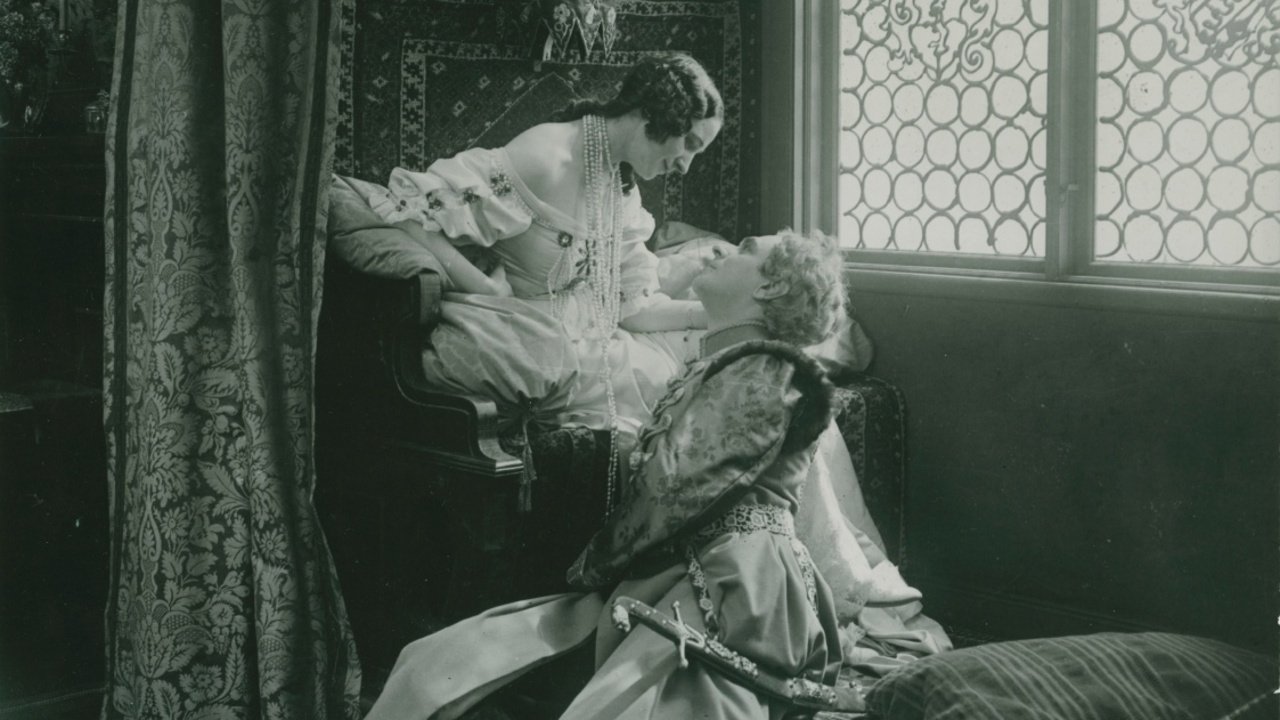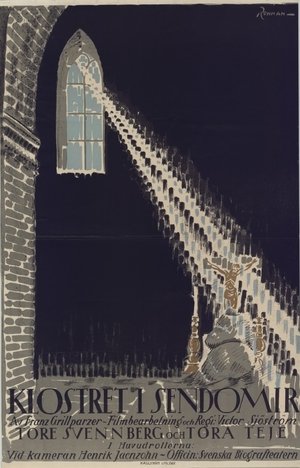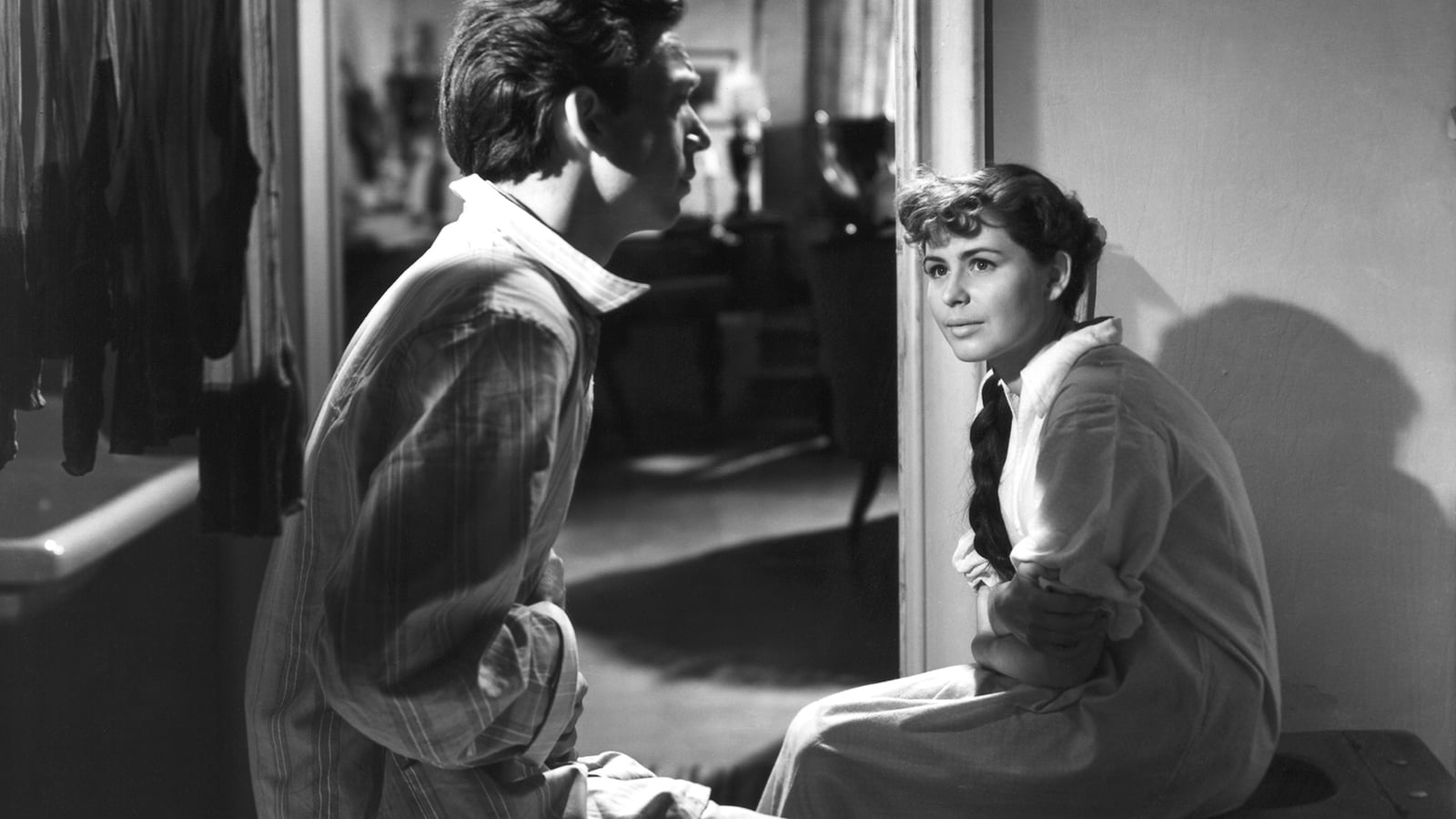Victor Sjöström was a pioneering figure in early Swedish and Hollywood cinema and is widely regarded as one of the greatest filmmakers of the silent era.
He was known for his visually stunning cinematography, powerful performances, and thought-provoking storytelling.
Here are some of his most well-received and highly acclaimed films that are considered must-sees for fans of silent cinema and the history of film:
- “The Phantom Carriage” (1921)
- “The Wind” (1928)
- “He Who Gets Slapped” (1924)
- “The Star of Bethlehem” (1917)
- “Körkarlen” (1921)
These films are widely celebrated for their beautiful cinematography, powerful performances, and thought-provoking storytelling, and they continue to be a major influence on filmmakers around the world.
Best Victor Sjostrom Films
If you’re a fan of silent cinema or the history of film, these films are well worth checking out.
1. Ingeborg Holm (1913)
“Ingeborg Holm” is a 1913 Swedish silent film directed by Victor Sjöström. The film is considered one of the earliest masterpieces of Swedish cinema and is widely regarded as a landmark in the history of film.
The film tells the story of Ingeborg Holm, a mother who loses custody of her children and is institutionalized.
The film is a powerful and emotionally charged drama that explores themes of motherhood, loss, and social injustice.
Sjöström’s direction and cinematography are masterful, with powerful performances from the cast and beautiful imagery that bring the story to life.
One of the highlights of “Ingeborg Holm” is Sjöström’s use of symbolism and visual storytelling to convey the film’s themes and emotions.
The film’s use of light and shadow, its effective editing, and its powerful score all serve to enhance the impact of the story.
Overall, “Ingeborg Holm” is a must-see for fans of silent cinema and the history of film. Its powerful storytelling, beautiful cinematography, and memorable performances make it a timeless classic and a true masterpiece of early Swedish cinema.
- theater organ soundtrack
- Hilda Borgstrom, Aron Lindgren (Actors)
- Victor Seastrom (Director)
- Audience Rating: NR (Not Rated)
2. A Man There Was (1917)
“A Man There Was” (Swedish title: “Terje Vigen”) is a 1917 Swedish silent film directed by Victor Sjöström.
The film is considered one of Sjöström’s greatest works and is widely regarded as a landmark in the history of film.
The film tells the story of Terje Vigen, a sailor who is forced to become a smuggler after his family is left without support.
The film is a powerful and emotional tale of love, loss, and the human spirit, with stunning cinematography and memorable performances.
Sjöström’s direction is masterful, with beautiful imagery, creative editing, and an evocative score that enhance the impact of the story.
One of the highlights of “A Man There Was” is Sjöström’s use of symbolism and visual storytelling to convey the film’s themes and emotions.
If you like Victor Sjostrom’s work, on our sister site AuteurGraph we have a profile page, a visual film timeline, and a ratings page that gives a tonne of info and data about their career in a visualized form.
The film’s powerful score and stunning landscapes add to the emotional impact of the story, making it a memorable and moving experience.
Overall, “A Man There Was” is a must-see for fans of silent cinema and the history of film. Its powerful storytelling, beautiful cinematography, and memorable performances make it a timeless classic and a true masterpiece of early Swedish cinema.
- Factory sealed DVD
- Victor Sjostrom, Edith Erastoff, Hilda Borgstrom (Actors)
- Victor Sjostrom (Director)
- English (Subtitle)
- Spanish (Publication Language)
3. Girl from Stormy Croft (1917)
“The Girl from Stormy Croft” (Swedish title: “Fröken Vildkatt”) is a 1917 Swedish silent film directed by Victor Sjöström.
The film is considered a classic of Swedish silent cinema and is widely regarded as a landmark in the history of film.
The film tells the story of a young woman from a remote village who moves to the city to escape poverty and build a better life for herself.
The film is a powerful and emotional tale of love, loss, and the human spirit, with stunning cinematography and memorable performances.
Sjöström’s direction is masterful, with beautiful imagery, creative editing, and an evocative score that enhance the impact of the story.
One of the highlights of “The Girl from Stormy Croft” is Sjöström’s use of symbolism and visual storytelling to convey the film’s themes and emotions.
The film’s powerful score and stunning landscapes add to the emotional impact of the story, making it a memorable and moving experience.
Overall, “The Girl from Stormy Croft” is a must-see for fans of silent cinema and the history of film. Its powerful storytelling, beautiful cinematography, and memorable performances make it a timeless classic and a true masterpiece of early Swedish cinema.
- Greta Almroth, Lars Hanson, Karin Molander (Actors)
- Victor Sjöström (Director)
- Audience Rating: NR (Not Rated)
4. The Outlaw and His Wife (1918)
“The Outlaw and His Wife” (Swedish title: “De röda skorna”) is a 1918 Swedish silent film directed by Victor Sjöström. The film is considered a classic of Swedish silent cinema and is widely regarded as one of Sjöström’s greatest works.
The film tells the story of a young couple who flee the law and take refuge in the wilderness. The film is a powerful and emotional tale of love, loss, and the human spirit, with stunning cinematography and memorable performances.
Sjöström’s direction is masterful, with beautiful imagery, creative editing, and an evocative score that enhance the impact of the story.
https://www.youtube.com/watch?v=00ESk3ht7C8
One of the highlights of “The Outlaw and His Wife” is Sjöström’s use of symbolism and visual storytelling to convey the film’s themes and emotions.
The film’s stunning landscapes, powerful score, and memorable performances add to the emotional impact of the story, making it a memorable and moving experience.
Overall, “The Outlaw and His Wife” is a must-see for fans of silent cinema and the history of film. Its powerful storytelling, beautiful cinematography, and memorable performances make it a timeless classic and a true masterpiece of early Swedish cinema.
- Amazon Prime Video (Video on Demand)
- Ingmar Bergman, Edith Erastoff, Victor Sjöström (Actors)
- Victor Sjöström (Director) - Victor Sjöström (Writer) - Charles Magnusson (Producer)
- (Playback Language)
5. Secret of the Monastery (1920)


The Monastery of Sendomir
1920 • 0h 54min • ★ 6.3/10 • Sweden
Directed by: Victor Sjöström
Cast: Tore Svennberg, Tora Teje, Renée Björling, Emil Fjellström, Axel Nilsson
Two riders on their way to Warsaw stop at a monastery for the night and ask an old monk there to tell them the story of its founding.
“The Secret of the Monastery” (Swedish title: “Klostret i Sendomir”) is a 1920 Swedish silent film directed by Victor Sjöström.
The film is considered a classic of Swedish silent cinema and is widely regarded as one of Sjöström’s important works.
The film tells the story of a young man who travels to a remote monastery to uncover the secrets of a mysterious organization.
The film is a suspenseful and atmospheric tale, with stunning cinematography and memorable performances.
Sjöström’s direction is masterful, with creative editing and an evocative score that enhance the impact of the story.
One of the highlights of “The Secret of the Monastery” is Sjöström’s use of symbolism and visual storytelling to create a tense and mysterious atmosphere.
The film’s evocative score and stunning landscapes add to the suspenseful and atmospheric tone of the story, making it a memorable and exciting experience.
Overall, “The Secret of the Monastery” is a must-see for fans of silent cinema and the history of film.
Its suspenseful and atmospheric storytelling, beautiful cinematography, and memorable performances make it a timeless classic and an important work of early Swedish cinema.
6. The Phantom Carriage (1921)
“The Phantom Carriage” (Swedish title: “Körkarlen”) is a 1921 Swedish silent film directed by Victor Sjöström. The film is considered a classic of Swedish silent cinema and is widely regarded as one of Sjöström’s greatest works.
The film tells the story of a man who is forced to relive his past misdeeds on New Year’s Eve. The film is a powerful and emotional tale of redemption, with stunning cinematography and memorable performances.
Sjöström’s direction is masterful, with creative editing, an evocative score, and innovative special effects that enhance the impact of the story.
One of the highlights of “The Phantom Carriage” is Sjöström’s use of symbolism and visual storytelling to convey the film’s themes and emotions.
The film’s stunning landscapes, powerful score, and memorable performances add to the emotional impact of the story, making it a memorable and moving experience.
Overall, “The Phantom Carriage” is a must-see for fans of silent cinema and the history of film.
Its powerful storytelling, beautiful cinematography, and memorable performances make it a timeless classic and a true masterpiece of early Swedish cinema.
- Factory sealed DVD
- Victor Sjöström, Hilda Borgström, Tore Svennberg (Actors)
- Arne Mattsson (Director)
- English (Subtitle)
- English (Publication Language)
7. Under the Red Robe (1937)
“Under the Red Robe” is a 1937 British historical drama film directed by Victor Sjöström. The film is based on the novel of the same name by Stanley Weyman and stars Robert Donat, Victor Francen, and Ann Todd.
The film is set in 17th century France and follows the story of a young man named Cardinal de Rohan who is appointed to be the Grand Inquisitor.
The film is a tale of political intrigue, with themes of power, corruption, and redemption.
The cinematography is beautiful and the acting is strong, especially from Robert Donat, who gives a captivating performance as the conflicted Cardinal.
Sjöström’s direction is effective, creating a lush and atmospheric world that captures the beauty and decadence of 17th century France.
The film’s score and production design add to the overall impact of the story, making “Under the Red Robe” a memorable and enjoyable experience.
Overall, “Under the Red Robe” is a well-made historical drama that is worth watching for fans of the genre and for those interested in the works of Victor Sjöström.
Its captivating story, beautiful cinematography, and strong performances make it a classic of British cinema and a testament to Sjöström’s talent as a filmmaker.
8. To Joy (1950)


To Joy
1950 • 1h 38min • ★ 6.9/10 • Sweden
Directed by: Ingmar Bergman
Cast: Maj-Britt Nilsson, Stig Olin, Birger Malmsten, John Ekman, Margit Carlqvist
After learning that his wife has been killed in an accident, a violinist looks back on their relationship.
“To Joy” (Swedish title: “Till glädje”) is a 1950 Swedish film directed by Victor Sjöström. The film tells the story of a struggling musician who must choose between his passion for music and his love for his family.
The film’s central performance by Birger Malmsten is noteworthy, capturing the struggles and triumphs of the protagonist with sincerity and emotion.
Sjöström’s direction is subtle and effective, exploring the themes of art, love, and family with nuance and depth. The film’s cinematography is beautiful, capturing the stunning landscapes of Sweden with a naturalistic eye.
https://www.youtube.com/watch?v=ybPa2HfS02w&t=366s
One of the highlights of “To Joy” is its use of music, which serves as a central element of the story. The film’s score is both beautiful and moving, elevating the emotional impact of the story and adding to its overall impact.
Overall, “To Joy” is a heartfelt and moving film that explores themes of art, love, and family with depth and nuance.
Its beautiful cinematography, moving score, and memorable performances make it a classic of Swedish cinema and a testament to Sjöström’s talent as a filmmaker.
No products found.
9. Wild Strawberries (1957)
“Wild Strawberries” (Swedish title: “Smultronstället”) is a 1957 Swedish film directed by Ingmar Bergman and starring Victor Sjöström.
The film is a deeply personal and introspective journey into the life and memories of an elderly professor, Isak Borg, who embarks on a road trip with his daughter-in-law.
Sjöström’s performance as Borg is a tour de force, capturing the character’s emotions, memories, and reflections with powerful nuance.
The film’s cinematography is beautiful, capturing the stunning landscapes of Sweden with a naturalistic eye.
Bergman’s direction is masterful, using the road trip to explore the protagonist’s life and memories in a non-linear fashion, resulting in a rich and complex examination of the human experience.
One of the highlights of “Wild Strawberries” is its use of dream-like sequences, which serve as a powerful visual metaphor for the protagonist’s journey through his past.
The film’s score is haunting and memorable, adding to the emotional impact of the story and elevating the film’s overall impact.
Overall, “Wild Strawberries” is a masterpiece of Swedish cinema and a defining work in the filmography of both Victor Sjöström and Ingmar Bergman.
Its powerful performances, beautiful cinematography, and rich exploration of the human experience make it a classic of world cinema and a must-watch for fans of art-house and foreign films.
- Wild Strawberries ( Smultronstället )
- Wild Strawberries
- Smultronstället
- Bibi Andersson, Ingrid Thulin, Gunnar Björnstrand (Actors)
- Ingmar Bergman (Director) - Wild Strawberries ( Smultronstället ) (Producer)
3 Characteristics of Victor Sjostrom Films
Victor Sjöström was a pioneering Swedish director and actor who left a lasting impact on the world of cinema. Three key characteristics of his films include:
Naturalistic style: Sjöström was known for his naturalistic approach to filmmaking, which emphasized realism and a focus on the beauty of the Swedish landscape.
His films often featured stunning cinematography that captured the essence of the natural world, imbuing his work with a sense of poetry and majesty.
Strong performances: Sjöström was a talented actor as well as a director, and many of his films featured powerful performances that elevated the emotional impact of the story.
He was known for his ability to create compelling and memorable characters, making his films deeply personal and introspective explorations of the human experience.
Exploration of the human experience: Sjöström’s films often dealt with themes of mortality, memory, and the passage of time, using his characters and stories to explore the complexities of the human experience.
His films were deeply personal and introspective, often focusing on the interior lives of his characters and the experiences that shaped their lives.
These themes are what make Sjöström’s films so memorable and impactful, cementing his legacy as one of the greats of world cinema.
3 Reasons Why You Should Watch Victor Sjostrom Films
Victor Sjöström was a pioneering Swedish director and actor whose films remain relevant and impactful today. Here are three reasons why you should watch his films:
Pioneering style: Sjöström was one of the early pioneers of the naturalistic style in filmmaking, which emphasized realism and a focus on the beauty of the natural world.
His films broke new ground in the art of cinema, and remain relevant and inspiring to this day.
Compelling performances: Sjöström was a talented actor, and many of his films feature powerful and memorable performances.
His ability to create compelling characters and explore the complexities of the human experience make his films must-sees for fans of world cinema.
Exploration of the human experience: Sjöström’s films often dealt with themes of mortality, memory, and the passage of time, and used his characters and stories to explore the complexities of the human experience.
These themes are universal, making his films impactful and memorable, and inspiring to audiences of all ages.
Whether you’re a fan of world cinema, art-house films, or introspective explorations of the human experience, Sjöström’s films are a must-see for anyone interested in the history and evolution of the medium.
Best Victor Sjostrom Films – Wrapping Up
Victor Sjöström is considered a pioneering filmmaker and is best known for his contributions to Swedish and American silent cinema. Some of his notable films include:
“The Phantom Carriage” (1921) – A haunting story of death and redemption that is considered one of the greatest silent films ever made.
“He Who Gets Slapped” (1924) – A melodramatic tale of a betrayed scientist who turns to the circus for solace and becomes a clown.
“The Wind” (1928) – A psychological drama about a woman who moves from the East to the West and must come to terms with the harsh reality of frontier life.
“Wild Strawberries” (1957) – A touching meditation on aging and the search for meaning in life that is widely regarded as one of Sjöström’s masterpieces.
Overall, Sjöström’s films are characterized by their emotional depth, powerful imagery, and thoughtful storytelling, and continue to be celebrated for their enduring impact on the art of cinema.








![The Phantom Carriage (The Criterion Collection) [Blu-ray]](https://m.media-amazon.com/images/I/51CfQLUak+L.jpg)



![Wild Strawberries ( Smultronstället ) [ NON-USA FORMAT, PAL, Reg.0 Import - United Kingdom ]](https://m.media-amazon.com/images/I/41A5c8KAipL.jpg)
